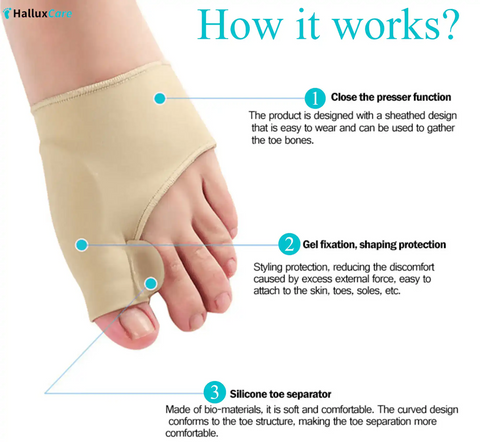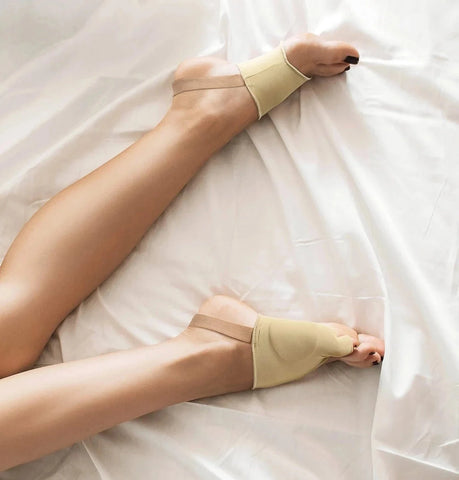The Hidden Dangers of Wearing Bunion Sleeves Inside Conventional Shoes
Last Updated: 2025-10-20
Author: Dr. Emily Carter, DPM — Board-Certified Podiatric Physician
Bunion pain relief is a crucial topic for anyone dealing with hallux valgus, commonly known as bunions. While bunion sleeves are marketed as a quick fix for discomfort, a recent Reddit comment and mounting podiatric evidence suggest a surprising risk: wearing these sleeves inside conventional, narrow shoes can actually worsen your bunion over time. Below, we’ll examine the medical reasons why, tips for safe use, and actionable steps for lasting relief.
Why Conventional Shoes and Bunion Sleeves Don’t Mix
The Medical Perspective
According to the American College of Foot and Ankle Surgeons, one of the primary causes of bunion progression is chronic compression of the forefoot, especially in shoes with a tight or pointed toe box ((ACFAS, 2023)). Bunion sleeves are designed to cushion and gently realign your big toe, but when used inside constrictive footwear, they can trigger unintended consequences:
- Compression Effect: The sleeve pushes the big toe outward, but a narrow shoe counteracts this by forcing it inward, increasing local pressure and friction.
- Deformity Progression: Instead of correcting the bunion, you may be forcing it against rigid material, accelerating joint deformity (Daniels, 2020, Journal of Foot and Ankle Research).
- Increased Inflammation: The combination of a sleeve and tight shoes often leads to more pain, redness, and swelling, according to clinical case studies ((Mayo Clinic, 2024)).
What’s Happening to Your Foot?
- The bunion sleeve is engineered for gentle realignment and cushioning.
- A tight toe box negates these benefits, pinching the toes further.
- This repetitive cycle can cause worsening discomfort and more rapid bunion progression.
4.9 ⭐⭐⭐⭐⭐ ( 1843 reviews)
How to Wear Bunion Sleeves for Maximum Relief
Choose the Right Footwear
Expert Tip: Dr. Jacqueline Sutera, DPM, recommends always pairing orthopedic devices with shoes that allow for natural toe splay ((American Podiatric Medical Association, 2023)). Here’s what to look for:
- Wide Toe Boxes: Select shoes that provide ample space for your toes to spread, reducing pressure on the bunion.
- Soft, Flexible Materials: Mesh or soft leather accommodates swelling and the extra bulk from a bunion sleeve.
- Minimal Drop Soles: Flat or low-heeled shoes reduce forefoot pressure, which is critical for bunion prevention and comfort.
Practical Tips for Safe Bunion Sleeve Use
- Use at Home: For best results, wear bunion sleeves when barefoot or with wide, soft slippers.
- Pair with Foot-Healthy Footwear: If you must wear shoes, opt for barefoot-inspired, orthopedic, or specialty shoes designed for bunion sufferers.
- Monitor Symptoms: If you notice increased pain or redness, stop using the sleeve and reassess your footwear.
Real-World Application
- Daily Routine: Use sleeves during relaxation or sleep, not during high-impact activities or in restrictive shoes.
- Travel: Pack wide, flexible shoes for trips where you’ll be walking more.
- At Work: If your job requires formal footwear, consider using bunion sleeves only during breaks or after-hours.
The Science: Why It Matters
Proper Alignment: Bunion sleeves work by gently repositioning the big toe, but only if not counteracted by tight shoes ((Harvard Health Publishing, 2023)).
Pain Relief: Used correctly, sleeves can reduce friction and inflammation, supporting overall joint health.
Slowing Progression: Consistent use in appropriate settings may slow or halt bunion progression, as supported by recent clinical guidelines (Daniels, 2020).
Bunion Relief: Products That Work
If you're looking for relief from bunion pain, consider using the Orthopedic Bunion Pain Relief & Correction Sleeve, which provides support and helps to alleviate discomfort.
For additional protection, the Tailor's Bunion Bunionette Pain Relief Protection Sleeves are designed to offer comfort and protection for bunionette pain.
To nourish and soothe the skin around bunions, as well as to promote healthy hair, consider the Jamaica Black Castor Oil Soothing Oil. Known for its moisturizing and anti-inflammatory properties, it helps alleviate discomfort around bunions and supports hair growth and scalp health.
Key Takeaways
- Never wear bunion sleeves inside narrow, conventional shoes: This can worsen bunion pain and speed up deformity.
- Pair bunion sleeves with wide, flexible footwear: This helps maximize their corrective and pain-relief benefits.
- Monitor your symptoms: Increased pain or redness means it’s time to reassess your approach.
- Use sleeves primarily at home or in spacious shoes: For best results, integrate sleeves into your daily relaxation and recovery routine.
Practical Tips & Real-World Applications
- Footwear audit: Check your closet for shoes with a wide toe box and soft construction—donate or retire those that are too narrow.
- Routine stretching: Pair bunion sleeve use with gentle foot stretches and toe exercises to enhance mobility (see AAOS foot exercises).
- Lifestyle balance: Use bunion sleeves during downtime or after work, rather than during periods of prolonged standing in dress shoes.
Frequently Asked Questions (FAQs)
Q: Can I wear bunion sleeves with sneakers?
A: Yes, as long as your sneakers have a wide toe box and flexible material. Avoid tight or stiff athletic shoes.
Q: How long should I wear bunion sleeves each day?
A: Most podiatrists recommend starting with 1–2 hours per day and gradually increasing as tolerated—primarily when not wearing restrictive shoes.
Q: Do bunion sleeves actually reverse bunions?
A: Bunion sleeves can relieve pain and slow progression, but they do not reverse bone deformity. Consistent use with proper footwear is key ((Mayo Clinic, 2024)).
Q: What shoes are best for bunion sufferers?
A: Shoes with a wide, deep toe box, soft uppers, and minimal heel elevation are strongly recommended by podiatric associations.
Q: When should I see a podiatrist?
A: If bunion pain persists despite conservative measures, or if you notice swelling, redness, or difficulty walking, consult a board-certified foot specialist.
Final Thoughts: Are You Helping or Hurting Your Bunions?
Wearing bunion sleeves in tight, conventional shoes can do more harm than good. For real relief and long-term foot health, combine high-quality bunion products with properly fitted shoes and healthy habits.
Have you found an approach that works for your bunion pain? Share your experience below—your story could help someone else walk more comfortably!




